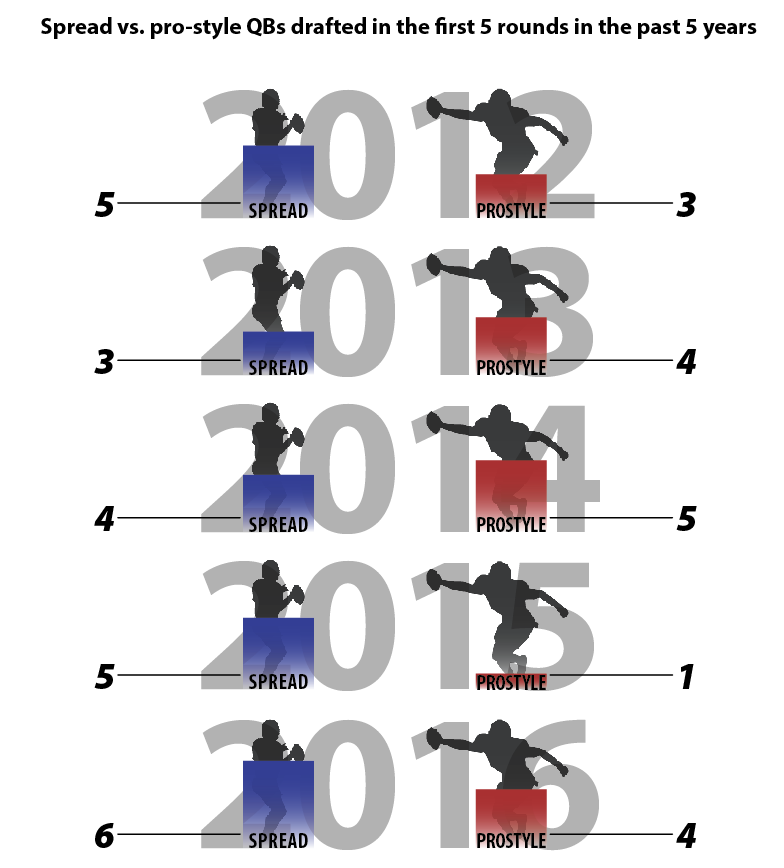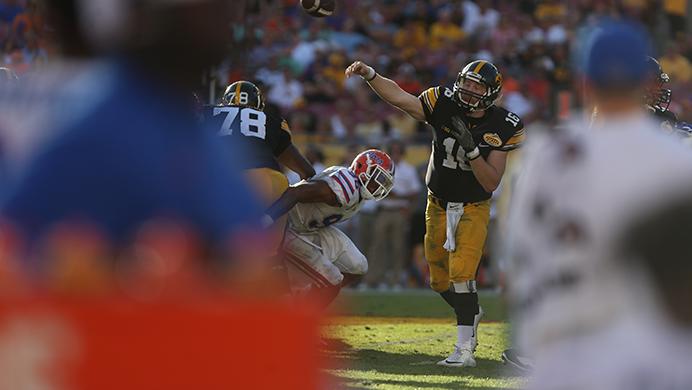By Blake Dowson
The first attribute listed under “strengths” on former Iowa quarterback C.J. Beathard’s draft profile on NFL.com is “played in pro-style passing attack.” Again, in the “bottom line” portion of the draft profile, the first thing listed is Beathard is a pro-style quarterback.
That is a good thing for his draft stock — in theory. “Pro-style” college quarterbacks, ones that take snaps from under center and from the shotgun and run offenses similar to NFL teams, have long been considered the better NFL prospects.
However, as more and more college teams shift to spread offense attacks and the NFL is following suit in many regards, the pro-style college quarterbacks are starting to be passed on.
One of the negatives on Beathard’s draft profile is he hasn’t been asked to make all the throws that an NFL quarterback has to make because of the system he was in — the pro-style system Iowa runs.
In the past five NFL drafts, 40 quarterbacks have been selected in the first five rounds. Only 17 to 20 of those quarterbacks have come out of pro-style systems, depending on how you define some college offensive schemes.
 So much of the scouting process leading up to the NFL Draft depends on the tape of each player. Todd McShay, one of ESPN’s draft experts, routinely says the NFL Combine and Pro Days are great, but watching tape is the best way to grade a player.
So much of the scouting process leading up to the NFL Draft depends on the tape of each player. Todd McShay, one of ESPN’s draft experts, routinely says the NFL Combine and Pro Days are great, but watching tape is the best way to grade a player.
Spread quarterbacks have plenty of tape to show off their arms and decision-making. Pro style quarterbacks such as Beathard, not so much.
A spread quarterback may have causes for concern in their tape, but if they throw 40 passes a game and connect on 20 really good throws, that fills a highlight tape rather quickly.
Beathard, especially in his senior season, was not granted that luxury in Iowa’s offense, when he didn’t have any real threats catching passes.
Of the eight mid-round (fourth and fifth round, where Beathard projects in many mock drafts) pro-style quarterbacks taken in the past five years (Connor Cook, Kevin Hogan, Tom Savage, Aaron Murray, AJ McCarron, Matt Barkley, Tyler Wilson, Kirk Cousins), only one signal-caller threw fewer passes than Beathard per game (23 per game): Stanford’s Kevin Hogan at 22 per game.
Even in Beathard’s junior year, when he had Tevaun Smith, Matt VandeBerg, and Henry-Krieger Coble to throw to, he only attempted 26 passes per game.
For comparison, not a single NFL playoff team (so, the teams doing things right in the league) threw fewer than 30 passes per game in 2016. The two Super Bowl teams both threw 34 passes on average.
That may be one of the biggest reasons Beathard isn’t projected to get drafted until the third day of the draft or possibly go undrafted.
Beathard has shown he can win games, which is what every team in the NFL is trying to do. In his two-and-change years of starting under center, he won 21 games. He also took Iowa to the Rose Bowl for the first time in 30 years.
He’s tougher than nails, every player on the roster would go to war for him, and he has enough mobility to be serviceable in the League.
But he didn’t sling the ball to his receivers 40 times a game and therefore falls behind Patrick Mahomes, Davis Webb, Chad Kelly, Seth Russell, and many other spread quarterbacks — they had a chance to showcase what their arms could do.
Beathard didn’t.



